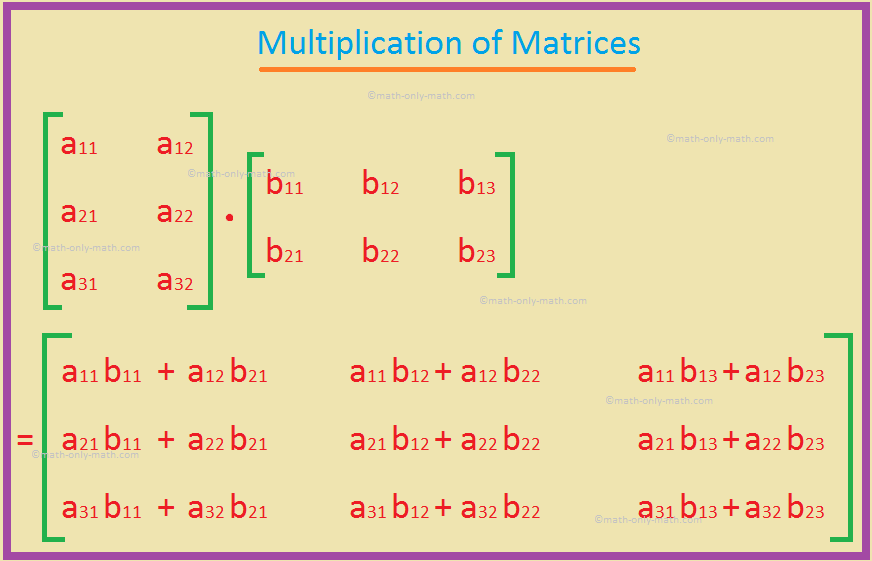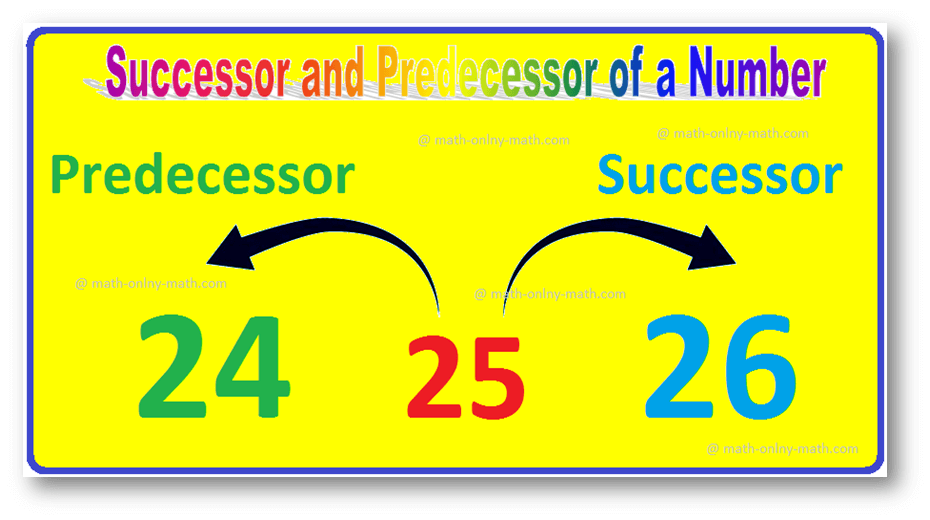Subscribe to our ▶️ YouTube channel 🔴 for the latest videos, updates, and tips.
Home | About Us | Contact Us | Privacy | Math Blog
Multiplication of Matrices
Two matrices A and B are said to be conformable for the product AB if the number of columns of A be equal to the number of rows of B.
If A be an m × n matrix and B an n × p matrix then their product AB is defined to be the m × p matrix whose (ij)th element is obtained by multiplying the elements of the ijth row of A into the corresponding elements of the jth column of B and summing the products so obtained.
In other words, if A = (aij) m, n, B = (bij) n, p then the product AB is a matrix of order m × p and AB = C = (cij) m, p where (cij) = ∑nk=1aikbkj, i = 1, 2, 3, ...., m; j = 1, 2, 3, ...., p.
The ijth element of the product AB is obtained by multiplying the corresponding elements of the ithrow of A and jth column of B and adding the products. This sum is called the inner product of the ith row of A and jth column of B. So the (ij)th element of the product AB is the inner product of the ith row of A and the jth column of B.
If the number of columns of A be not equal to number of rows of B, then AB is not defined.
Let A = [a11a12a21a22a31a32] and B = [b11b12b13b21b22b23]
Here we can see that the matrix A has two columns and the matrix B has two rows. Therefore, A and B are conformable for the product AB.
Thus the product of the matrix A and the matrix B = AB = [a11a12a21a22a31a32] . [b11b12b13b21b22b23]
= [a11b11+a12b21a11b12+a12b22a11b13+a12b23a21b11+a22b21a21b12+a22b22a21b13+a22b23a31b11+a32b21a31b12+a32b22a31b13+a32b23]
In the product AB, A is said to be a pre-factor or pre-multiplier
and B is said to be a post factor or post-multiplier.
It is obvious that the products AB and BA are two distinct entities. Indeed, one of them may exist while the other may not. In order that both AB and BA should exist, if A be the order of m × n, B must be of order n × m. In this case, however, AB and BA are matrix of different orders. In order that both AB and BA should exist as matrices of the same order, both A and B must be square matrices of the same order.
Note: Matrix multiplication is not commutative. That is, for two matrices A and B, AB ≠ BA, in general.
First of all, if we choose the orders of A and B to be m × n and n × m respectively so that the conformability conditions for both the products AB and BA are satisfied then we observe that the orders of AB and BA are m × m and n × n respectively and therefore AB cannot be equal to BA.
In order that AB and BA may be equal, both of them must be of the same order and this requires that A, B must be square matrices of the same order. However if we choose the order of A and B to be n × n and n × n, then although AB and BA become matrices of the same order, they may not be equal, in general. This can be shown by taking at random.
A = [1520], B = [3−146]
Here AB = [23296−2], BA = [1151620].
In some special cases, however, AB = BA.
For example, let A = [1223], B = [1001].
Here AB = [1223], BA = [1223].
Definition: Two matrices A and B are said to commute with each other if AB = BA. Since AB = BA, A and B must be square matrices of the same order.
Examples of Commuting Matrices:
1. Let A be a square matrix. Then A commutes with A itself.
2. Let A be a square matrix of order n. Then A commutes with In, because A . In = In . A = A.
3. Let A be a square matrix of order n. Then A commutes with On,n, because A. On,n = On,n . A = On,n.
4. Let A be square matrix of order n. Then A commutes with the scalar matrix cIn, because A . cIn . A = cIn . A = cA.
From Multiplication of Matrices to HOME
Didn't find what you were looking for? Or want to know more information about Math Only Math. Use this Google Search to find what you need.
Recent Articles
-
Successor and Predecessor | Successor of a Whole Number | Predecessor
Jul 29, 25 12:59 AM
The number that comes just before a number is called the predecessor. So, the predecessor of a given number is 1 less than the given number. Successor of a given number is 1 more than the given number… -
Worksheet on Area, Perimeter and Volume | Square, Rectangle, Cube,Cubo
Jul 28, 25 01:52 PM
In this worksheet on area perimeter and volume you will get different types of questions on find the perimeter of a rectangle, find the perimeter of a square, find the area of a rectangle, find the ar… -
Worksheet on Volume of a Cube and Cuboid |The Volume of a RectangleBox
Jul 25, 25 03:15 AM
We will practice the questions given in the worksheet on volume of a cube and cuboid. We know the volume of an object is the amount of space occupied by the object.1. Fill in the blanks: -
Volume of a Cuboid | Volume of Cuboid Formula | How to Find the Volume
Jul 24, 25 03:46 PM
Cuboid is a solid box whose every surface is a rectangle of same area or different areas. A cuboid will have a length, breadth and height. Hence we can conclude that volume is 3 dimensional. To measur… -
Volume of a Cube | How to Calculate the Volume of a Cube? | Examples
Jul 23, 25 11:37 AM
A cube is a solid box whose every surface is a square of same area. Take an empty box with open top in the shape of a cube whose each edge is 2 cm. Now fit cubes of edges 1 cm in it. From the figure i…







New! Comments
Have your say about what you just read! Leave me a comment in the box below. Ask a Question or Answer a Question.